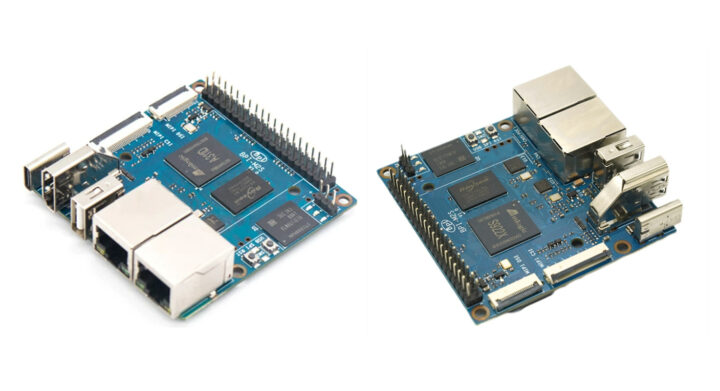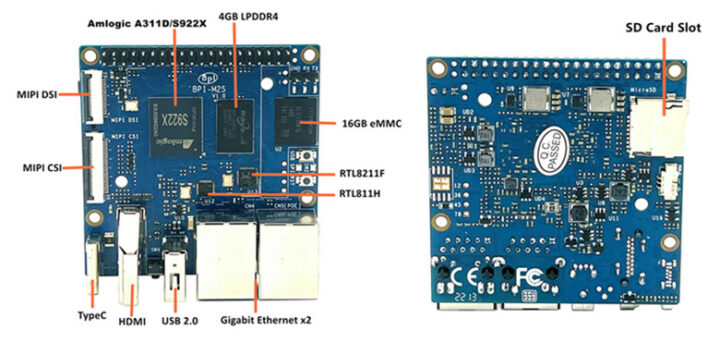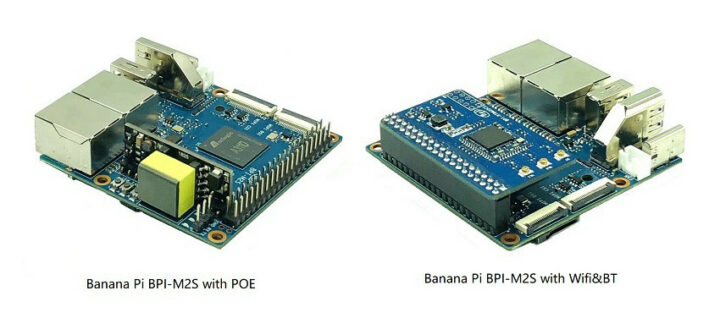The Banana Pi PPI-M2S is a single board computer (SBC) powered by either Amlogic A311D or S922X processor with 4GB RAM, 16GB eMMC flash, HDMI 2.1 and MIPI DSI display interfaces, one MIPI CSI camera connector, two Gigabit Ethernet ports with one PoE capable, as well as optional WiFi 5 & Bluetooth support.
When we first covered the Banana Pi BPI-M2S over a year ago, all we had were some 3D renders of the board and some preliminary specifications. The company has now manufactured the board, provided some documentation, and started to take orders for the board on Aliexpress for $95.79 or $100 depending on whether Amlogic S922X or A311D is selected.
Banana Pi BPI-M2S specifications:
- SoC – Amlogic A311D or S922X hexa-core processor with 4x Arm Cortex-A73 cores @ 2.21 GHz, 2x Arm Cortex-A53 cores @ 1.8 GHz, Arm Mali-G52 MP4 (6EE) GPU with OpenGL ES 3.2, Vulkan 1.0 and OpenCL 2.0 support, 5 TOPS NPU on A311D only
- System Memory – 4GB LPDDR4
- Storage – 16GB eMMC flash, MicroSD card slot
- Video interfaces
- HDMI 2.1 output up to 4Kp60
- MIPI DSI connector for display (A311D only)
- MIPI CSI connector for camera (A311D only)
- Networking
- 2x Gigabit Ethernet ports one via RTL8211F GbE transceiver, the other through RTL8111H PCIe to Gigabit Ethernet transceiver
- Optional WiFi 5 and Bluetooth 5.0 via Realtek RTL8822CS module
- USB – 1x USB 2.0 Type-A port, 1x USB Type-C port
- Expansion – 40-pin Raspberry Pi-compatible header with GPIO, PWM, I2C, UART, SPI, I2S, IR, signals for WiFi and Bluetooth module
- Debugging – 3-pin header for serial console
- Misc – USB and Reset buttons, 2x LEDs
- Power Supply
- 5V via USB-C port or pin header
- Optional PoE module
- Dimensions – 65 x 65mm
Banana Pi says the BPI-M2S has the same size as the earlier Banana Pi BPI-M2+ and Banana Pi BPI M2 Pro, but considering the arrangement of the ports is much different, I’m not sure it matters. The Amlogic A311D/S922X processor is also much more powerful than the Allwinner H3 and Amlogic S905X3 SoCs found in the two other boards. You can find more about the performance in Android 9 in our review of Khadas VIM3 Pro based on the A311D SoC.
The Amlogic A311D and S922X processors are pretty similar, but the latter does not include the 5 TOPS NPU and does not support the MIPI CSI and DSI interfaces of the BPI-M2S SBC. While the specifications list support for both PoE and WiFi/Bluetooth, the two features are mutually exclusive as can be seen in the photo below showing either the POE module fitted to its 4-pin header or the wireless module connected to the 40-pin GPIO header.
The company provides more information and Android 9, Ubuntu 20.04, and Debian 10 OS images in the wiki. But note that, as usual, some of the information is wrong or incomplete, for instance, they shamelessly copied the preliminary specifications from the first CNX Software article, which stated there are three buttons based on the 3D renders, while there are now only two buttons following a small design change, and did not update the info. Also worth noting is that the Linux BSP hosted on GitHub relies on U-boot 2015.1 & Linux kernel 4.9.236.

Jean-Luc started CNX Software in 2010 as a part-time endeavor, before quitting his job as a software engineering manager, and starting to write daily news, and reviews full time later in 2011.
Support CNX Software! Donate via cryptocurrencies, become a Patron on Patreon, or purchase goods on Amazon or Aliexpress








More bananaware…. Something the world waited for – not.
When do the copy&paste sinovoips of this world finally go out of business?
When Android 9 is Depreciated :p
with R6s already on sell, this looks like doa
OpenWrt is working on NanoPi R6S, but I’ve spent four hours trying to install Ubuntu or Debian with no success so far.
DEBIAN 10 is working fine in the NanoPi R6S (SD installation)
https://www.pcdemano.com/revisiones/21837/11/
Are you running from the SD card or are you using the eFlasher image to flash the OS from SD to eMMC flash?
I’ve tried both the eFlasher and USB methods to flash Ubuntu minimal and desktop, and Debian images. The USB method fails after a while with an error message in Chinese. The eFlasher method appears to work, but the board won’t boot. I eventually soldered the UART header, and I get no output at all after flashing Ubuntu. The serial console works when I go back to OpenWrt or even while the eFlasher update is running.
I’ve contacted FriendlyElec, they say it works on their side, and don’t seem interested in looking into it.
You have already given and expended alot of your time, given media attention to product review and free fault finding. Their are more you could do but why should you work unpaid as a volunteer?
Neither you or Friendly would want or care for my solution, implementation is not cheap.
I’m using OpenWRT running in the eMMC and Debian 10 directly from the SD card.